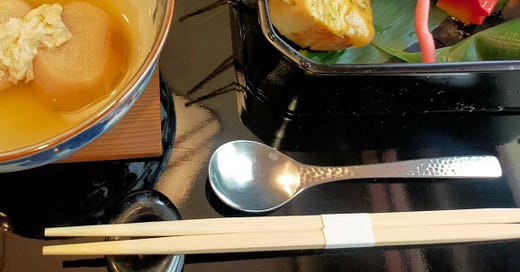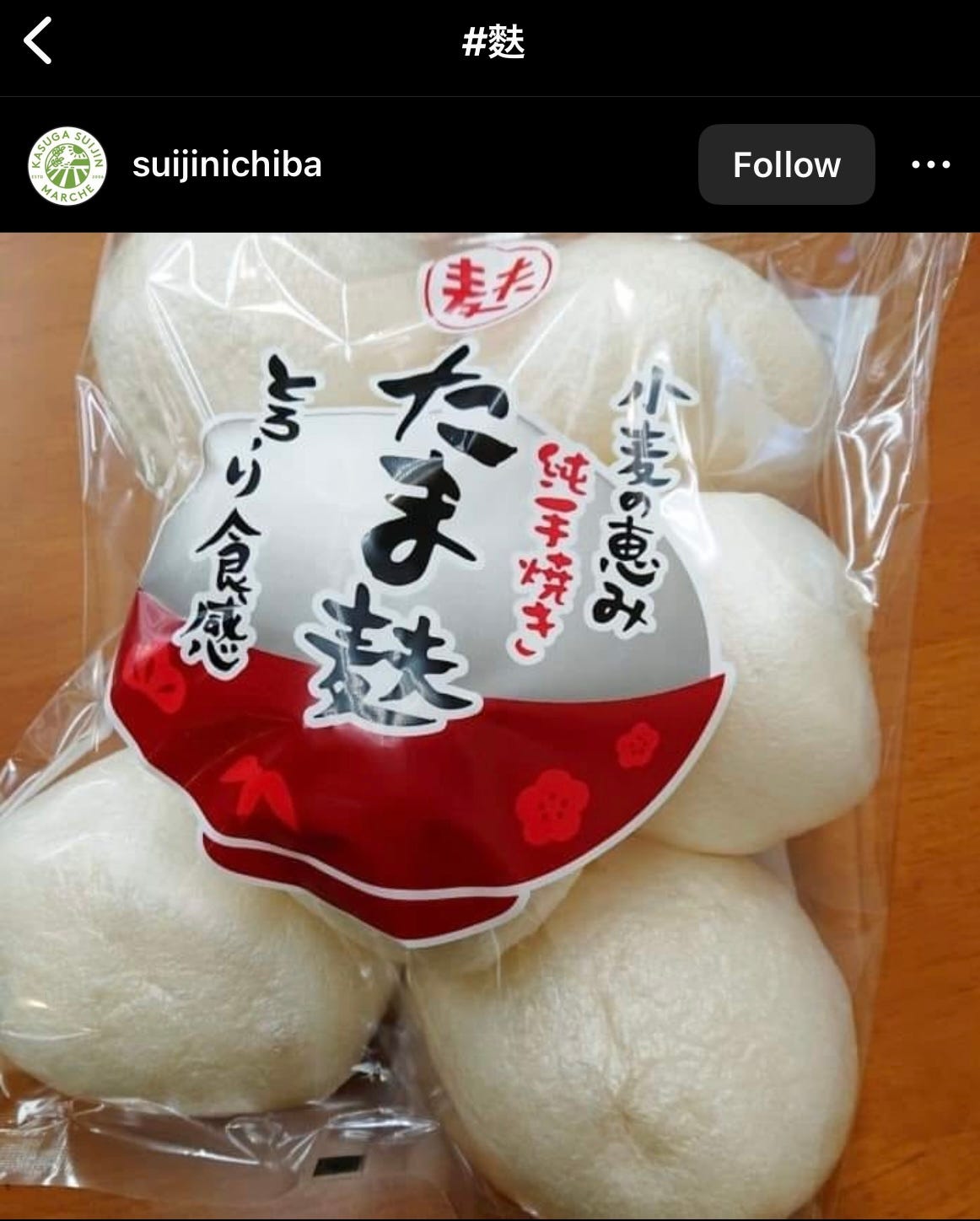So many traditional Japanese foods are plant-based, and all are dairy-free. Really, the only thing keeping traditional (as in, pre-19th century when the westernization of Japan led to the consumption of beef and beef dishes like sukiyaki1), Japanese food from being entirely vegan is fish. But even despite the subtle notes of bonito-based dashi that might pervade even the simplest ohitashi (blanched spinach that is chilled and seasoned, usually with soy and sesame - but often with a sprinkle of bonito flake), Japan has a strong culture of shojin ryori - or vegan preparations for Buddhist monks. It’s not correct of me to characterize this as strictly Japanese, as the practice (naturally given that Buddhism is not native to Japan) exists throughout Asia.
Most of my (and I imagine that of others) cringe reaction to vegan foods is when those foods expressly try to mimic the non-vegan version. For one, I am certain that the aversion of many Americans to tofu is because it has been stamped for so long (thank you hippies) as a bland tofu source that can be seasoned like meat. I mean, if I were in the mood for a barbecued pork chop and was served spiced tofu, I’m sure I’d be disappointed too. But I love tofu, and even as I have been happily simmering it into beextravegant-inspired saags in-lieu of paneer (lighter and higher in protein, I tell myself, and not because I never have paneer on hand) because (as she points out), it is literally a soy cheese, I should be thinking of it the other way around and thinking of mozzarella as cow tofu2.
Seitan - 正しいタンパク, aka the Correct Protein
Regardless, a long meandering way of saying that as I have convinced myself that high protein and high fiber foods most of the time will at least somewhat make up for the vast quantities of ice cream I consume, I have been on the hunt for plant-based sources of protein and came upon seitan, or wheat gluten. I had never tried seitan, or so I thought, because I had always thought of it as a crunchy chicken substitute invented by hippies. But seitan is actually a wheat gluten-derived meat substitute developed in Chinese monasteries that is also eaten in Japan as hu麩 that is high in protein.3 It was coined “seitan” by George Osawa, who (from what I can gather), was born into a poor samurai family, but left Japan for Paris and New York and wrote Zen Macrobiotics in 1960. Sei = 正しい and tan = タンパク = the correct protein.
Any, seitan/hu/麩 is made by kneading flour and then washing out the starch, leaving only the wheat gluten, or the protein. As a result, it is high in protein and low in sugar. In Japan, especially in Kyoto, there are shops that specialize in serving it fresh (nama-hu), often grilled on skewers and topped with miso, but also shaped into flowers. It is chewy like mochi, and is one of my favorite things to eat.
An assortment of hu, including as skewers and shaped into a maple leaf.
Separately, it is also available dried throughout the country and is often reconstituted and added to soups.
A bag of dried hu
Anyway, I am insanely late to this trend. In addition to Americans, Japan has also been on the bandwagon as to the nutritional benefits of hu. As certain varietals of dried hu are available in long, baguette-like wands, they are reconstituted and soaked in an egg/milk custard and griddled like french toast. Or they are reconstituted and marinated in mirin and soy before being coated in potato starch and fried like kara-age.
And thus we are back where we started with seitan as fried chicken, except that somehow, I know that kara-age’d hu will be delicious. Also see here a video for hu as a substitute for unagi.
I am also curious about traditional Chinese preparations. Would love to try this dish where it is braised with mushrooms.
But now I wonder about sourcing for all of these hu recipes. I’m still working through a bag that I bought in Niigata, but didn’t find any on my last trip to Tenichi (which is admittedly small) and did not see any sale at the Rice Factory.
Dengaku inspired dip
And finally, a way to get some of the flavor of one of my other favorite Japanese (and also vegan!) eggplant dishes as an easy dip. My maternal grandmother, Mikiyo, was the eggplant whisperer and made many an eggplant dish, including dengaku, where eggplant is grilled and topped with sweet miso and sesame. However, I can’t always get Japanese eggplants in Brooklyn, and American eggplants, bulbous as they are, don’t have the right texture for dengaku.
Actually, I don’t really know what you do with American eggplants, but given two very large ones were hulking in the fridge, I decided to mush them into a dip inspired by my favorite dish.
I cut two eggplant lengthwise, brush with some olive oil, and bake them face down in a 400 degree oven for approximately 20 minutes, or until the face down sides are deeply golden and the skin is crinkled.
Scoop the eggplant out of the skin and into a bowl, spoon in ~1-2 tablespoons tahini and ~1-2 tablespoons miso and stir until smooth (eggplant cooks this way really just melts).
Top with sesame seeds and possibly scallions if you would like to add some dimension to the mush. Very good on cucumbers. No pictures, because it looks like the “gray stuff” from Beauty and the Beast, but yes, it’s delicious.
Other crunchy things to try
Somewhere on TikTok, I found a video where someone whizzed the melon seeds (along with the stringy bits that come with it when you scoop out a melon) and make “melon seed milk,” and I’ve been doing it ever since. It’s fairly self explanatory, but add about 2-3 times the volume of seed/pulp with water and blend. You can strain it, but I don’t bother. It’s like a vaguely melony almond milk.
Blending in a tablespoon of chia seeds into my green smoothies (usually whatever I have in the fridge, cut with some fruit and lemon) seems to make the smoothie separate much less (or at least less quickly).
I saw Mother Play and Merrily We Roll Along this week. The chemistry of the actors is amazing (and all of the leads for both are Tony-nominated)!
Sukiyaki, a dish of thinly sliced beef simmered with negi (Japanese leeks), onions, and greens is not something I see often on menus in NYC. But it was apparently so popular in 1985 that the Japanese song, Ue o muite arukou (Looking up as I walk) by Kyu Sakamoto was released in the U.S. titled “Sukiyaki.” Thankfully it’s a bit of a better situation these days with Japanese media in the U.S., although it’s mainly anime, brooding films that win at Cannes, and Japanese stories with random white characters (as much as I did enjoy both Shogun and Tokyo Vice).
The fear of tofu in the U.S. irks me to no end - please see all of the countries that have consumed tofu for centuries (and boast longer life spans).
However, I have not yet done the diligence as to whether the amino acids in wheat-gluten derived proteins are as accessible to us as those from animal products.






Comparison of tofu vs seitan protein quality, also see the link at the end to the vegan protein guide.
https://dietitiandebbie.com/seitan-vs-tofu-nutrition-taste-and-recipes/